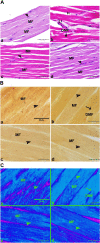Impact of porous microsponges in minimizing myotoxic side effects of simvastatin
- PMID: 37031209
- PMCID: PMC10082807
- DOI: 10.1038/s41598-023-32545-0
Impact of porous microsponges in minimizing myotoxic side effects of simvastatin
Abstract
Simvastatin (SV) is a poorly soluble drug; its oral administration is associated with a significant problem: Myopathy. The present study aims to formulate SV microsponges that have the potential to minimize the myotoxicity accompanying the oral administration of the drug. SV microsponges were prepared by exploiting the emulsion solvent evaporation technique. The % entrapment efficiency (%EE) of the drug approached 82.54 ± 1.27%, the mean particle size of SV microsponges ranged from 53.80 ± 6.35 to 86.03 ± 4.79 µm in diameter, and the % cumulative drug release (%CDR) of SV from microsponges was significantly higher than that from free drug dispersion much more, the specific surface area of the optimized microsponges formulation was found to be 16.6 m2/g revealed the porosity of prepared microsponges. Histological and glycogen histochemical studies in the skeletal muscles of male albino rats revealed that microsponges were safer than free SV in minimizing myotoxicity. These findings were proven by Gene expression of Mitochondrial fusion and fission (Mfn1) & (Fis1) and (Peroxisome proliferator-activated receptor gamma co-activator 1α) PGC-1α. Finally, our study ascertained that SV microsponges significantly decreased the myotoxicity of SV.
© 2023. The Author(s).
Conflict of interest statement
The authors declare no competing interests.
Figures






Similar articles
-
Development and evaluation of xanthan gum-facilitated ethyl cellulose microsponges for controlled percutaneous delivery of diclofenac sodium.Acta Pharm. 2011 Sep 1;61(3):257-70. doi: 10.2478/v10007-011-0022-6. Acta Pharm. 2011. PMID: 21945905
-
Design and evaluation of colon specific drug delivery system containing flurbiprofen microsponges.Int J Pharm. 2006 Aug 2;318(1-2):103-17. doi: 10.1016/j.ijpharm.2006.03.025. Epub 2006 Mar 29. Int J Pharm. 2006. PMID: 16687222
-
Nebivolol-Loaded Microsponge Gel for Healing of Diabetic Wound.AAPS PharmSciTech. 2017 Apr;18(3):846-854. doi: 10.1208/s12249-016-0574-3. Epub 2016 Jun 29. AAPS PharmSciTech. 2017. PMID: 27357423
-
A Review About the Drug Delivery from Microsponges.AAPS PharmSciTech. 2018 May;19(4):1501-1511. doi: 10.1208/s12249-018-0976-5. Epub 2018 Feb 26. AAPS PharmSciTech. 2018. PMID: 29484616 Review.
-
Therapeutic Application of Microsponges-based Drug Delivery Systems.Curr Pharm Des. 2022;28(8):595-608. doi: 10.2174/1381612828666220118121536. Curr Pharm Des. 2022. PMID: 35040411 Review.
Cited by
-
Formation of PEG-PLGA Microspheres for Controlled Release of Simvastatin and Carvacrol: Enhanced Lipid-Lowering Efficacy and Improved Patient Compliance in Hyperlipidemia Therapy.Polymers (Basel). 2025 Feb 21;17(5):574. doi: 10.3390/polym17050574. Polymers (Basel). 2025. PMID: 40076067 Free PMC article.
-
Enhancing skin residence time of penciclovir for the treatment of cold sores: formulation and characterization of controlled release microsponges.Naunyn Schmiedebergs Arch Pharmacol. 2025 Aug 8. doi: 10.1007/s00210-025-04506-z. Online ahead of print. Naunyn Schmiedebergs Arch Pharmacol. 2025. PMID: 40779156
-
Mitochondrial Fission as a Therapeutic Target for Metabolic Diseases: Insights into Antioxidant Strategies.Antioxidants (Basel). 2023 May 27;12(6):1163. doi: 10.3390/antiox12061163. Antioxidants (Basel). 2023. PMID: 37371893 Free PMC article. Review.
References
MeSH terms
Substances
LinkOut - more resources
Full Text Sources

